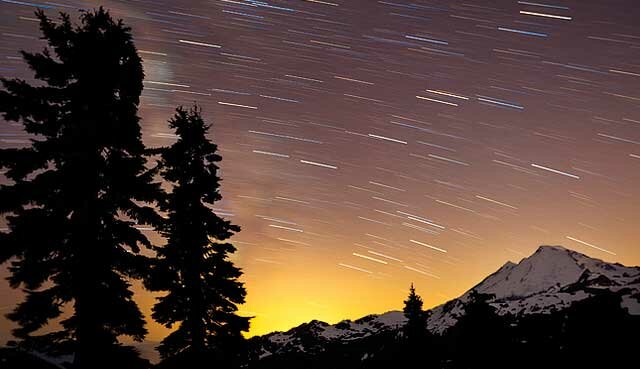 |
Shooting starsPrime viewing sites of the PerseidsBy Sue MadsenA rim of yellow fading to cerulean blue outlines the horizon to the west, but overhead the sky is a deep indigo with stars just beginning to wink. We lay out our camping pads on the springy heather and settle back with arms behind our heads. Suddenly a bright flash streaks across the sky from the east. It’s the first shooting star of the night – and the Perseids meteor shower has begun! The Perseids are one of the most prolific meteor showers of the year. They’re especially rewarding to view because they peak in mid-August, a perfect time to plan a backpacking trip for stargazing. The name Perseids refers to the sons of Perseus, as the point from which the meteors appear to originate lies in the constellation of Perseus, named after the Greek hero who slew the gorgon Medusa and rescued the princess Andromeda. Catholics sometimes refer to the Perseids as the “Tears of St. Lawrence,” since the saint was martyred on August 10. Observations of the Perseid meteor shower date back at least 2000 years, with the earliest reports coming from the Chinese in 36 AD where it was said “more than 100 meteors flew thither in the morning.” The shower is comprised of a stream of dust and cosmic debris in the tail of the comet Swift-Tuttle, which was discovered in 1862. Most meteors are smaller than a grain of sand and almost always burn up or disintegrate before hitting the Earth’s surface. The shower is visible from mid-July to late August each year, with peak activity happening between August 9 and 14. This year, the peak is predicted to occur the night of August 12, when the rate of meteors reaches 60 or more per hour. Contrast this with the last night meteors are likely to be seen from this shower (August 22), when you might see one every hour or so. This should be an excellent viewing year, as the moon will be waning toward new, and moonrise is late (after 1 a.m.). As with all meteor showers, the rate is greatest in the pre-dawn hours. No specialized viewing equipment is needed, as the meteors are easily seen with the naked eye. Watching the Perseids is a summertime ritual for many, and planning a backpacking trip around the peak activity is one of the best ways to enjoy the show. Good viewing sites are located far from city lights and have an unobstructed horizon to the northeast. WHERE TO GO One of my favorite locations is the Park Butte Lookout/Mazama Park area on the south flank of Mt. Baker. Access the area on trail 603 from the Schreiber’s Meadow trailhead off USFS Road 13 in the Mt. Baker Ranger District. The trail crosses Rocky Creek, which may not have a bridge. Crossing can be challenging during periods of heavy runoff, so be sure to check in at the Sedro Woolley Ranger Station before heading out. Campsites are available at Cathedral Camp, about 3.5 miles in, or about 2.5 miles further west at Mazama Park. If you are staying more than one night, the area makes a great base camp for exploring a series of mountain meadows with stunning views of Mt. Baker. Side trips include the Park Butte Lookout (5,450 ft.), which is a short hike up the ridge from Cathedral Camp, and Railroad Grade, a glacial moraine that provides an up close and personal view of the Easton Glacier. As an added bonus, the trip can be done as a 7.5 mile loop by returning down Scott Paul trail, which joins trail 603 just before the Schreiber’s Meadow parking area. Yellow Aster Butte up Highway 542 along the North Fork Nooksack is also an excellent choice for late summer star gazing. Start on trail 686 off of the Twin Lakes Road about 12 miles east of the town of Glacier. Climb up approximately 1,500 feet over about a mile and a half to the trail junction just south of Gold Run Pass. Take the left fork and contour around Yellow Aster Butte for another 2.5 miles. Designated camping areas are located about 200 feet below the summit trail in a heathery meadow amongst a number of small tarns (lakes). Beyond the tarns are cross-country unmarked routes to High Divide and Tomyhoi Peak. WHAT TO BRING You’ll need a Northwest Forest Pass for these hikes. Passes cost $30 annually, or $5 for day pass, and can be obtained at any USFS office or from local vendors. Always check before heading out to assess current trail conditions. The Mt. Baker-Snoqualmie National Forest website provides relatively current information on road and trail conditions www.fs.usda.gov/detail/mbs/recreation/?cid=stelprdb5126323. X |